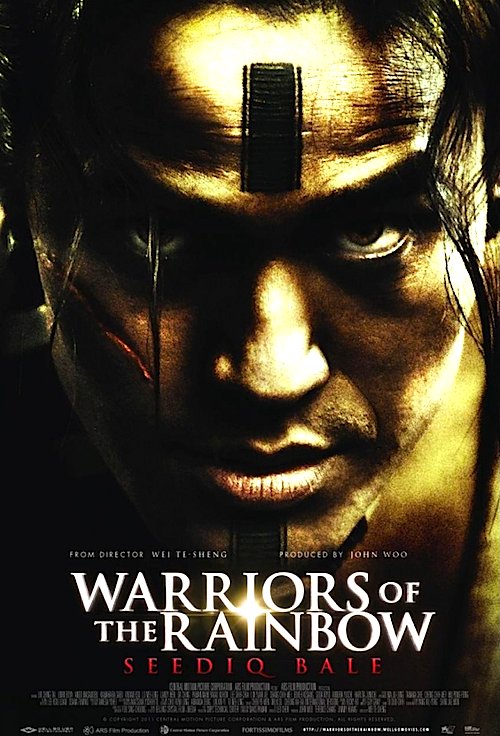By Joe Bendel. For the aboriginal peoples indigenous to Taiwan, decapitating an enemy’s head in battle was an essential rite of manhood. In the early twentieth century, the occupying Japanese began the systematic suppression of aboriginal culture. It would cost them a whole lot of heads. Originally well over four hours long, Wei Te-sheng’s Warriors of the Rainbow: Sediq Bale in its more theatrical booking-friendly two and a half hour international cut opens this Friday in New York.
Mouna Rudao was one of the fiercest Seediq warriors ever. When the Japanese confiscate his collection of skulls, they are duly impressed. Unfortunately, as chief he must watch as the old ways atrophy under their oppressive rule. The tattoos of manhood are becoming scarce. However, this will change during the 1930 Wushe Uprising.
It started with a misunderstanding between Mouna’s family and the local Imperial authorities, snowballing from there. The Seediq forces strike first, ambushing the Japanese at a major sporting exhibition. Things only get bloodier thereafter. Frankly, Mouna knows their revolt is doomed to fail, but at least the young Seediq men will die as warriors, crossing over the Rainbow Bridge to their equivalent of Valhalla.
 Submitted by Taiwan as their most recent official foreign language Academy Award candidate, Rainbow was released as two films in most Asian markets. However, the edited and cobbled together international version makes perfect sense from a narrative standpoint and includes plenty of Braveheart-style action. One suspects the axe fells disproportionately heavily on the female cast, including the great Vivian Hsu, who are rarely seen in the 150 minute cut until an emotionally devastating scene late in the picture.
Submitted by Taiwan as their most recent official foreign language Academy Award candidate, Rainbow was released as two films in most Asian markets. However, the edited and cobbled together international version makes perfect sense from a narrative standpoint and includes plenty of Braveheart-style action. One suspects the axe fells disproportionately heavily on the female cast, including the great Vivian Hsu, who are rarely seen in the 150 minute cut until an emotionally devastating scene late in the picture.
It is too bad Mel Gibson went more or less insane, because he would have been the perfect celebrity “presenter” for Rainbow, executive-produced by John Woo, no less. There are death-scenes that will make you exclaim out loud. Yet, despite the frequent references to the Rainbow Bridge, there is little that could be deemed mystical or New Agey about the film, at least in its international configuration. It also resists the temptation to glorify Seediq traditionalism, unequivocally suggesting tribalism undermined their efforts to defeat the Imperial Japanese with a united front.
Lin Ching-Tai is all business as the steely old Mouna. He might just the best middle-aged action hero since the Eastwood of decades ago. Yet young Lin Yuan-Jie might be the most engaging member of the ensemble cast. There is absolutely nothing cute or cloying about his riveting work as Pawan Nawi. Japanese actor Sabu Kawahara also somehow manages to elevate the role of the stereotypically severe General Kamada Yahiko, while Chie Tanaka is memorably vulnerable as the wife of a relatively sympathetic Imperial officer.
Rainbow parallels the pronounced trend in current Mainland and Hong Kong films depicting Japanese characters in explicitly villainous terms. Indeed, the impulse to constantly re-fight WWII is becoming rather suspicious. Be that as it may or may not be, there is no denying Rainbow delivers the epic action goods. This is a big, bloody picture, serving as a perfect example of the bold filmmaking fostered by Fortissimo Films. Definitely recommended for fans of large scale historical action films, Rainbow opens this Friday (4/27) in New York at the AMC Empire.
LFM GRADE: B
Posted on April 23rd, 2012 at 2:36pm.